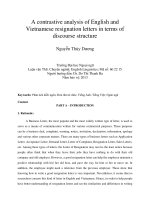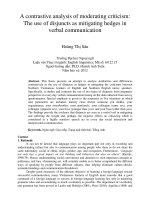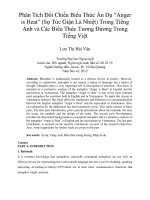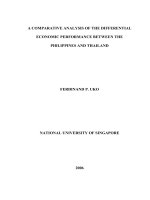A contrastive Analysis of the Metaphor “Anger is Heat” in English and the Possible Equivalent Expressions in Vietnamese
Bạn đang xem bản rút gọn của tài liệu. Xem và tải ngay bản đầy đủ của tài liệu tại đây (231.12 KB, 12 trang )
Phân Tích Ðối Chiếu Biểu Thức Ẩn Dụ “Anger
is Heat” (Sự Tức Giận Là Nhiệt) Trong Tiếng
Anh và Các Biểu Thức Tương Ðương Trong
Tiếng Việt
Lưu Thị Hải Vân
Trường Đại học Ngoại ngữ
Luận văn ThS ngành: Ngôn ngữ Anh; Mã số: 60 22 15
Người hướng dẫn: Assoc. Pr. Võ Ðại Quang
Năm bảo vệ: 2012
Abstract: Metaphor is traditionally treated as a rhetoric device in poetics. However,
according to cognitivists, metaphor is not merely a matter of language but a matter of
thought. Metaphor plays a very important role in description of emotions. This thesis is
intended as a contrastive analysis of the metaphor “Anger is Heat” in English and the
equivalents in Vietnamese. The metaphor “Anger is Heat” is one of the most common
used metaphors for emotions both in English and in Vietnamese. To make this clearer to
Vietnamese learners, this study offers the similarities and differences in conceptualization
between the English metaphor “Anger is Heat” and the equivalent in Vietnamese. Also,
an explanation for the differences has been tentatively given. This study consists of three
parts. The first part, Introduction, gives general information about the rationale, the aim,
the scope, the methods and the design of the study. The second part, Development,
provides the theoretical background on conceptual metaphor and a contrastive analysis of
the metaphor “Anger is Heat” in English and the equivalents in Vietnamese. The last part,
Conclusion, is focused on the specific conclusions on each of the research objectives.
Also, some suggestions for further study are given in this part.
Keywords: Ẩn dụ; Tiếng Anh; Biểu thức tương đương; Phép ẩn dụ
Content
PART A: INTRODUCTION
1. Rationale
It is common knowledge that metaphors, especially conceptual metaphors are not only an
effective device for representing the world outside language but also a tool for thinking, speaking
and acting. According to Ortony (1975) there are at least three communicative functions that
metaphor might perform.
Lakoff and Johnson (1980:3) state that “metaphor is pervasive in everyday life, not just in
language but in thought and action” and “our conceptual system is largely metaphorical, then the
way we think, what we experience, and what we do every day is very much a matter of
metaphor.”
During my study, I have been interested in metaphors especially conceptual metaphors for
emotions; therefore I choose conceptual metaphors as my thesis topic. Of many everyday
conceptual metaphorical expressions I would like to take a careful study on the conceptual
metaphor “Anger is Heat”. “Anger” is one of abstract concepts of people‟s emotions that are
highly used in English and in Vietnamese. How is this metaphor used differently in the two
languages? These are the main reasons for my study “A Contrastive Analysis of the Metaphor
“Anger is Heat” in English and the Possible Equivalent Expressions in Vietnamese”.
2. Aims and objectives of the study
The study tries to:
- give a systematic account of the theoretical background on conceptual metaphors.
- make explicit the similarities and differences between the English metaphor “Anger is Heat”
and the possible equivalent expressions in Vietnamese.
- propose implications for teaching metaphors.
3. Research questions
The objectives mentioned above can be elaborated into the following research questions:
- What are similarities and differences in regard to how the English metaphor “Anger is Heat”
and the Vietnamese equivalent are perceived?
- What causes the differences in cognitive mechanism of this metaphor between the two
languages?
- What are the possible recommendations for teaching English metaphors?
4. Scope of the study
In this thesis, I only work on the metaphor “Anger is Heat” in English and the possible
equivalents in Vietnamese to work out the contrast of cognitive model/ mechanism and to give
explanation for the differences in the metaphor usage between the two languages.
5. Methodology of the study
5.1. Principles governing the research
5.1.1 Principles governing the choice of research type
This study is intended to provide an overview and a contrastiveness of the metaphor “Anger is
Heat” in English and the Vietnamese equivalent. To achieve the aims, the type of research
chosen is basic research.
A combination of qualitative and quantitative approaches is employed with priority given to
qualitative analysis. The qualitative method is used to describe and analyze the common and
distinctive features of the metaphor “Anger is Heat” in English and the equivalent expressions
in Vietnamese.
5.1.2. Data-related issues
The researcher examines different samples containing metaphorical expressions belonging to the
central conceptual metaphor “Anger is Heat” from books, previous studies, novels, stories, and
the Internet in both English and Vietnamese. Then the commonly used metaphorical expressions
are selected to be analyzed. The samples are authentic sources of data. Research procedure
follows the research design and principles strictly. So the validity and the reliability of the study
can be guaranteed.
5.2. Methods of the study
5.2.1. Major methods and supporting methods
The study has been carried out with the combination of different methods. The major method
employed in this thesis is contrastive analysis to compare and contrast mechanism of the
metaphor “Anger is Heat” in the two languages. The intended instrumental language herein
assumed is Vietnamese and the target language is English. Besides, the descriptive method is
used as supporting one.
5.2.2. Data collection instruments
Document analysis and observation are employed as data collection instruments. Document
analysis is used to seek instances of the metaphor “Anger is Heat” in English and the
Vietnamese equivalents in books, previous studies, novels, and on the Internet. The observation
technique is used to enhance qualitative analysis of the established details related to cognitive
mechanism in the specified area of research.
5.2.3. Data analysis techniques
After being collected, the data are analyzed by using the following techniques:
- Classifying the samples collected into two sub-versions of the central metaphor “Anger is
Heat” based on the corresponding source domains.
- Systematizing is used to categorize the samples into metaphorical entailments in accordance
with their meanings.
- Inferring the similarities and differences of the metaphor “Anger is Heat” in English and the
possible equivalents in Vietnamese.
6. Structure of the thesis
The paper is divided into three parts as follows:
Part A is “Introduction”. This part gives a brief account of the rationale of the study, the aims of
the study, the scope of the study, the methods of the study, and the thesis structure.
Part B is “Development”. This part consists of two chapters. Chapter one is “Literature Review”.
This chapter provides the background for the study. Chapter two, “A Contrastive Analysis of the
Metaphor “Anger is Heat” in English and the Possible Equivalent Expressions in Vietnamese”,
provides a contrastive analysis of the English metaphor “Anger is Heat” and the Vietnamese
equivalents.
Part C, “Conclusion”, provides a recapitulation of the main points raised, concluding remarks on
each of the objectives, and suggestions for further studies.
PART B: DEVELOPMENT
CHAPTER ONE: LITERATURE REVIEW
1.1 Review of the previous studies
1.2. Theoretical background
1.2.1. Traditional approach to metaphors
1.2.1.1. Substitution theory
The substitution theory describes metaphors as expressions, which are simply substitutes for
literal expressions (Black: 1955).
The problem with this view is that a metaphor may evoke a large number of connotations and it
would be difficult to paraphrase them all; and paraphrasing of a metaphorical expression cannot
present all the meanings that the original metaphorical expression has (Ohkura: 2003).
1.2.1.2. Comparison theory
According to comparison theory, metaphor is grounded in the similarity existing between two
concepts involved in it, so metaphor is considered to be an implicit comparison between
principal subject and subsidiary subject, Black (1955), Hoang Tat Truong (1993). On such a
view, the interpretation of a metaphor is a matter of interpreting the corresponding simile, and
the truth of the metaphor is thus reduced to that of the simile.
The problem with this view is that similarity is a symmetric relation, whereas, in reality,
metaphor is often asymmetric.
1.2.2. Cognitive approach to metaphor
1.2.2.1. What is a conceptual metaphor?
For Lakoff and Johnson (1980) metaphor is not a matter of language but of thought processes.
Therefore, they are not interested in metaphor as linguistic expressions but as concepts behind
the expressions. They do not even attempt to provide an adequate definition for metaphor but
describe the use of it as “understanding and experiencing one kind of thing in terms of another”
(p. 5).
1.2.2.2. Metaphorical mapping
The cognitive process that relates literal meanings to extended meanings is known as mapping. A
mapping is the systematic set of correspondences that exist between constituent elements of the
source and the target domain. The source domain is predominantly associated with some tangible
physical experiences and therefore it is more concrete than the target domain (Esenova: 2000).
As a result, to know a conceptual metaphor is to know the set of mappings that applies to a given
source-target pairing.
1.2.2.3. The structure of a conceptual metaphor
A conceptual metaphor is about two domains of thought and not just using one word instead of
another, the structure of a conceptual metaphor is complex.
According to Kövecses (2002) in conceptual metaphor, “conceptual domain” is a critical concept
in cognitive theories of metaphor. We rely on our knowledge and experience on one concept in
order to understand another concept. Therefore, “a conceptual metaphor consists of two
conceptual domains, in which one domain is understood in terms of another,” (Kövecses: 2002,
p. 4). We have special names for these two conceptual domains. They are called source domain
and target domain respectively Lakoff &Johnson (1980), Kövecses (2002).
1.2.2.4. Types of conceptual metaphors
1.2.2.4.1. Structural metaphors
The structural metaphor concept is perhaps Lakoff and Johnshon‟s (1980) foremost metaphor
classification. They defined it as “cases where one concept is metaphorically structured in terms
of another” (p. 14). Metaphorical structure is characterized by two spatial structures called two
conceptual domains: source domain and target domain.
1.2.2.4.2. Orientational metaphors
Another kind of metaphorical concept is called an orientational metaphor, which organizes a
whole system of concepts with respect to one another. These typically deal with spatial
orientation, such as up-down, in-out, front-back, on-off, deep-shallow, and central peripheral.
1.2.2.4.3. Ontological metaphors
Ontological metaphorical expressions occur when people try to impose substances and entities
with discrete boundaries on abstract concepts such as events, activities, emotion, and so on
(Lakoff & Johnson, 1980). According to Lakoff and Johnson (1980: 25), understanding our
experiences in terms of objects and substances allows us to pick out parts of our experience and
treat them as discrete entities or substances of a uniform kind.
1.2.2.4.4. Conduit metaphor
Another type of conceptual metaphor which is found in (at least the everyday English) language
is conduit metaphor. This conceptual metaphor states that ideas are manipulatable things that can
be packed into words and language, and then transferred (given or sent) to someone, who can
subsequently unpack the words to uncover the ideas inside.
1.2.2.5. Metaphorical entailment
A conceptual metaphor refers to understanding one idea (conceptual domain) in terms of another.
This understanding is based on set of mappings of the source domain onto the target domain. We
usually have richer knowledge about source domain. When this rich knowledge about elements
is mapped onto target domains, we have cases of metaphorical entailment. Therefore a
metaphorical entailment can be defined as the imparting of a characteristic of the source domain
(the metaphorical image) to the target domain (the concept receiving metaphorical treatment) by
logical means.
1.2.2.6. The role of conceptual metaphors in description of emotions
Metaphor might allow people to express emotions which are difficult or impossible to express if
they are restricted to literal uses of language (Ortony and Fainsilber: 1987). In other words,
metaphor is a powerful device for communicating emotion from two distinct perspectives.
Emotions are abstract concepts. The relation of an emotion to other concepts tends to make the
emotion more concrete, as Corlenia M. Verspoor (1993) points out in his research that
“Metaphors are extremely pervasive in language. They provide a powerful manner of making
abstract concepts explicit. For these reasons, they are frequently utilized to describe emotional
state.”
1.2.3. Summary
To sum up, we can say that metaphor is not only a matter of language; it is a matter of thought. It
is not used only in poetics but also pervasive in everyday conversations. And metaphors play a
central role in expression of emotional state. And this is one of the bases for this study though it
only deals with one conceptual emotional metaphor “Anger is Heat”.
CHAPTER 2
A CONTRASTIVE ANALYSIS OF THE METAPHOR “ANGER IS HEAT” IN ENGLISH
AND THE POSSIBLE EQUIVALENT
EXPRESSIONS IN VIETNAMESE
2.1 The cognitive basis of the metaphor „Anger is Heat” in English and the equivalent in
Vietnamese
2.1.1 The cognitive basis of the metaphor “Anger is Heat” in English
2.1.2. The cognitive basis of the equivalent metaphor “Anger is Heat” in Vietnamese
2.2. The metaphor “Anger is Heat” in English and the equivalent in Vietnamese
2.2.1. The version “Anger is the Heat of a Hot Fluid in a Container” in English and the
Vietnamese equivalent
2.2.1.1. The entailment “Increase in the intensity of anger is the rising of the fluid”
2.2.1.2. The entailment “Intense anger produces steam and pressure on the container”
2.2.1.3. The entailment “When anger becomes too intense, the person explodes”
2.2.1.4. The entailment “When a person explodes, parts of him go up in the air”
2.2.1.5. The entailment “When a person explodes what was inside him comes out”
2.2.2. The English version “Anger is Fire” and the Vietnamese equivalent
2.3. Explanation for the differences of the metaphor “Anger is Heat” in English and the
equivalent in Vietnamese
Both English and Vietnamese share the same central metaphor for anger: “Anger is Heat” and
they both share the two sub-versions: “Anger is the Heat of a Hot Fluid in a Container” and
“Anger is Fire”. However, English tends to utilize the whole body in conceptualizing anger;
while Vietnamese tends to utilize more body parts.
English mainly utilizes the physiological effects of the whole body to describe anger. There are
few expressions in English in which parts of body are used to conceptualize anger. Three parts
which are often used are head, face, and blood vessel.
According to Lakoff and Kovecses (1983), the use of “face” and “head” are based on the
physiological experience that when body temperature and pressure increase, face and neck area
becomes red. This is visible physiological effect. The case of “burst a blood vessel” is quite
common in everyday use. Why “blood vessel” is used not other parts like heart, liver, or lung? In
England, the rate of heart disease is very high, is the leading cause of death. Based on their
fundamental medical knowledge English people know that excessive pressure will cause blood
vessels burst. State of extreme anger can cause pressure increase dramatically. It can be said that
modern medical knowledge affects the model of conceptualization of English people.
In contrast, Vietnamese people are affected by knowledge of Oriental medicine. Vietnamese
traditional medical theories, which are deeply influenced by Chinese ones, affect the model of
conceptualization of Vietnamese people. These medical theories follow the theory of Yin-Yang
and the theory of five elements. Chinese traditional medicine applies these theories to account
for the relations between humans and nature, between the internal organs inside the human body,
and between the internal organs and the external body parts.
According to the theory of five elements, the Zang and Fu organs liver and gall and eyes, which
belong to the element Wood, are categorized to anger. This is the basis for expressions like
“nóng mắt”, “mắt long (song sọc)”, “sôi mật”, “sôi gan”. About eyes, they are used in many
expressions for emotions basing not only on the Yin-Yang theory and the five element theory but
also on Vietnamese culture which considers eyes as “the windows of the soul” expressing
people‟s states of emotions.
Although intestine (small and large intestine) and heart are categorized to happiness and grief,
they are also used to express anger as in expressions “sôi ruột”, “nổ ruột”, “sôi tim”. What are
the reasons for this? First about heart, it can be seen under the cultural aspect. Vietnamese people
consider heart as the central organ of people which can contain all states of emotions like anger,
happiness, anxiety, grief, and fright; therefore, it is applied to express not only state of happiness
according to Yin-Yang theory and five element theory but all other states of emotions.
According to Oriental medicine, intestine and liver are organs of digestive system and are
interrelated. When someone gets angry, blood in his/her liver becomes hot, it leads to intestinal
juice becomes hot. This is the basis for the expression “sôi ruột”. Also related to Oriental
medicine, steam is one of the two important elements (steam and blood) which help organs in the
body act normally. When someone gets angry, circulation of steam in liver is hampered. When
the circulation of the Yin steam in liver is hampered, it causes the one of the Yang steam in
intestine to be hampered (Trần Bá Tiến: 2009). This is the basis for the expressions “nổ ruột”.
In summary, cultural aspect and medical knowledge form the differences in the
conceptualization of anger between English and in Vietnamese.
2.4. Summary
Basing on what have been discussed in this chapter, it is possible now to have a clear view on the
metaphor “Anger is Heat” in the two languages:
- The cognitive basis of the metaphor “Anger is Heat” in both languages is the same and based
on bodily experiences.
- English tends to express anger through the physiological effects of the whole body; while
Vietnamese tends to utilize body parts to express anger.
- Differences in culture and medical knowledge cause differences in conceptualization between
the two languages
PART C: CONCLUSION
1. Recapitulation
The study has fulfilled its aims with the following major points presented:
Firstly, the study has provided a brief account for conceptual metaphor.
Secondly, it has investigated the cognitive basis of the metaphor “Anger is Heat” in English and
the Vietnamese equivalents.
Thirdly, the study has analyzed cognitive mechanism of the metaphor “Anger is Heat” in the
two languages. English usually describes anger through the physiological effects of the whole
body; in contrast, Vietnamese tends to utilize body parts.
The study has also explained the reason why there are differences between the two languages.
These differences result from differences in culture and medical knowledge.
2. Concluding remarks
The first objective to be gained in this thesis is to give a theoretical background on conceptual
metaphor. Some remarks may be drawn that: metaphor is not only a matter of language, but a
matter of thought; and metaphor is not limited only in poetics but popularly used in everyday
language, so language learners should utilize it to make their communications more effective.
The second objective of the thesis is to make explicit the similarities and differences between the
English metaphor “Anger is Heat” and the possible equivalent expressions in Vietnamese.
Conceptual metaphors for emotions in general and the conceptual metaphor “Anger is Heat” in
particular are mainly grounded on bodily experience. Bodily experience is universal among all
human beings. So different languages, English and Vietnamese may share the same conceptual
metaphors. However, differences always exist between languages because language is linked to
culture. Therefore, differences in cultures can lead to differences in languages.
The last but not least object of this thesis is to give implications for teaching metaphors.
Metaphors are highly used in everyday English, so teaching metaphorical expressions is essential
and important. Here are some implications that the author hope, to some extend, will help
teachers in teaching metaphors:
- When teaching metaphorical expressions, teachers should provide not only meanings
but also the background of the expressions, cultural and structural features of the
expressions. This can help learners effectively build semantic memories of the
metaphorical expressions in English.
- In teaching metaphorical expressions, teachers should put them in contexts.
When expressions are put in contexts, students may guess their meanings and understand
how they are used, so that it is easier for students to remember metaphorical expressions.
- Contrasting and comparing the English metaphorical expressions to Vietnamese may
also be an effective way. This technique may be employed for different tasks such as
translation and reading. When teaching, teachers should highlight metaphorical
expressions in texts of translating or reading, and then contrast and compare them to
Vietnamese. Through contrast and comparison with Vietnamese, teachers can provide
students awareness of the metaphorical universal concepts used in the two languages
which help them use metaphorical expressions correctly and effectively.
3. Suggestions for further studies
It can not be denied that this study is limited in many ways. The data, especially in Vietnamese,
were mainly collected from the Internet, so they may lack reality. Therefore, all the remarks and
comments on the study will be highly appreciated.
This study only has made an investigation of the central metaphor for anger “Anger is Heat”,
which is based on bodily experiences. There are also other metaphors for anger formed from
bodily experiences such as “Anger is Insanity, Anger is an Opponent” and so on. Therefore, it
is hereby suggested that future studies be conducted on all central metaphors for anger yielded
by the folk theory of physiological effects of anger. If conducted in this direction, studies will
give the readers a relatively complete system of metaphorical expressions for anger so that they
can enrich their knowledge as well as apply in their daily conversations to make it more
effective.
References
English
1. Black, M. (1955). Metaphor. Proceedings of the Aristotelian Society, New Series,
Vol. 55 (1954 - 1955), p. 273-294
2. Esenova, O. (2009). Anger metaphors in the English language. Varieng, 3
3. Koller, V. (2003). Metaphor clusters in Business Media Discourse: A Social
Cognition Approach. University of Vienna. Ph.D. thesis.
4. Kovecses, Z (2000). Metaphor and Emotions. in The Cambridge Handbook of
Metaphor and Thought, Raymon W and Gibbs Jr. Cambridge University Press.
5 Kovecses, Z (2002). Metaphor: A Practical Introduction. Oxford University
Press.
6. Lakoff, G and Johnson M (1980). Metaphor We Lived By. The University of
Chicago Press.
7. Lakoff, G and Kovecses, Z (1983) The Cognitive Model of Anger Inherent in
American English. Berkeley Cognitive Science Report.
georgelakoff.files.wordpress.com/ /the-cognitive-model-of-anger-in
8. Ortony, A. (1975). Why Metaphors Are Necessary and Not Just Nice,
Educational Theory, 25, 45-53.
9. Ohkura, C. (2003). The Semantics of Metaphor in the Game Theoretic Semantics
with at Least Two Coordination Equilibria. Lexicon and Figurative Language, Vol 14,
56-63.
10. Ortony, A and Fainsilber, L (1987) The Role of Metaphor in Descriptions of
Emotions. dl.acm.org/ft_gateway.cfm?id=980346&type=pdf
11. Reddy, M.J (1979) The conduit metaphor: A case of Frame conflict in Our
Language about Language.
www.biolinguagem.com/ /reddy_1979_conduit_metaphor.pdf
12. Richards, J.C., Platt, J., and Platt, H. (1992). Dictionary of Language Teaching
& Applied Linguistics. Longman.
13. Hoang Tat Truong. (1993). Basic English Lexicology. National University
College of Foreign language.
14. Verspoor, C.M (1993). What are Characteristics of Emotional Metaphors
citeseerx.ist.psu.edu/viewdoc/download?doi=10.1.1.55 rep
Vietnamese
15. Trần Bá Tiến (2007). Ẩn Dụ Về Sự Tức Giận Và Niềm Vui Trong Tiếng Anh
Và Tiếng Việt, Tạp chí Ngôn Ngữ, 7, 22-34
16. Lê Ðình Tư (2010). Chúng Ta Làm Gì Khi Tức Giận.
t%E1%BB%A9c-
gi%E1%BA%ADn/









